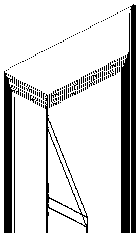17c/45 orthogonal
17c/45 orthogonal is an orthogonal speed equal to seventeen forty-fifths of the speed of light.
| 17c/45 orthogonal | ||
| ||
| Spaceship | Yes | |
|---|---|---|
| Puffer | Yes | |
| Rake | Yes | |
| Wickstretcher | No | |
| Gun | No | |
Spaceships
The first example of a 17c/45 orthogonal spaceship, the caterpillar, was constructed by Gabriel Nivasch with the help of Jason Summers and David Bell. The caterpillar is based on the 17c/45 reaction in which a Pi-heptomino non-destructively climbs a trail of blinkers at speed 17c/45. Another basis for the caterpillar is a 17c/45 helix composed entirely of standard spaceships, that releases a forward glider every 270 generations while moving 102 cells forward. David Bell discovered that interactions between two Pi-crawlers could produce backward gliders, and a long search by Gabriel Nivasch found one that shoots forward gliders. These glider streams are used to create the helix as well as to clean up the blinker trails. Although it is possible to create higher-period 17c/45 spaceships, none have been explicitly constructed. Another 17c/45 helix is known that has a period of 450 and so spaceships with periods that are multiples 450 could, in theory, be constructed.
Puffers
Due to the pi-crawler's ability to create gliders, creating 17c/45 puffers and rakes is relatively simple.
See also
- List of important speeds
- List of spaceships with speed 17c/45
- List of crawlers with speed 17c/45
External links
- 17c/45 spaceship at the Life Lexicon
- The 17c/45 Caterpillar spaceship by Gabriel Nivasch
